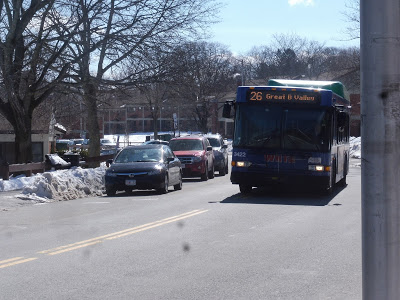It’s time for the 23’s cousin route, the 26! We’ll be covering a lot of familiar territory in this review, but we start off at a unique section: Great Brook Valley.
 |
| The bus at Great Brook Valley. |
The route technically starts at the Great Brook Valley Pool, but Sam and I were a little dubious of that as a starting point, so we waited at the next stop, inside the Great Brook Valley apartment development. We boarded the bus on Tacoma Street, running down through the development. Next, we turned onto Boylston Street, which had houses and businesses on one side and industrial buildings on the other.
 |
| Lots of apartments. |
We went around a rotary onto Lincoln Street, running past industrial buildings that turned into suburban businesses with parking lots. At the Lincoln Mall, we were joined by the 23, and thus the independent section was over. The suburban businesses continued until a huge office building before we went under I-290.
 |
| Hey, I took a picture of this exact same sign on the 23! |
There were houses along Lincoln Street until we reached Brittan Square, where we were joined by the 14 and we passed businesses and a hospital. It felt much more urban, even when the square ended, with dense apartments and some retail along the road. Going under I-290 again, we merged onto Major Taylor Boulevard, taking us past tall office buildings with parking lots. Finally, it was a left on Foster Street, and it was a straight shot to the Central Hub.
 |
| Wow, a rare sunny picture at the Central Hub! |
WRTA Route: 26 (Union Station Hub – Great Brook Valley via Lincoln Street)
Ridership: The 26 gets amazing ridership – in fact, it’s the second-busiest WRTA route on weekdays, and the busiest on weekends! The bus gets 1,117 people per weekday, 738 per Saturday, and 283 per Sunday. My morning Saturday trip got a full 20 people going inbound, which is great!
Pros: Like the 23, the 26 provides direct service down Lincoln Street, serving slightly different places at the end of the route. We know from before that both routes run every half hour on weekday to provide 15-minute service along Lincoln Street, but the 26 actually goes every half hour on Saturdays, too!
Cons: Unfortunately, that drops to every 65 minutes on Sundays. Why it can’t be every 60, I don’t know – it’s given more time than on Saturdays, which doesn’t make much sense. Also, there are a few weird service patterns here: on weekdays, there’s a timepoint for the “Great Brook Valley Community Center,” but no trips actually serve it; also, there are a few trips that only go to Great Brook Valley without running all the way to the pool, which just seems…weird. I mean, they’re less than a minute apart! Why does this route even serve the pool in the first place? And actually, why is it given five minutes to get from the pool to Great Brook Valley when that’s way too much time? Finally, like I said on the 23, the coordination between these routes needs to be a lot more obvious.
Nearby and Noteworthy: Basically the same stuff as the 23. Maybe the pool is fun in the summer!
Final Verdict: 7/10
I think this is a better route than the 23 because it comes more frequently on Saturdays and it has fewer timepoint issues. However, the coordination between these two routes needs to be better. Well, here’s something radical: what if we combine them? I can’t get the map to work properly for some reason (the timepoints move to the wrong places), but a link to it is here if you’re interested. Meanwhile, here’s the schedule (full version here):
Basically, I combined the two routes into a loop-like service, with buses serving one leg in one direction and the other leg in the other direction. There are two ways of going about this: one is to have every bus operate in the same direction every trip, and the other is to alternate between trips. I decided to do the latter option, just so that neither route gets preferential treatment. Passengers could stay on the bus to go around to their destination, although the layover time at The Fairways makes it inefficient to do – maybe all the layover could be at the Central Hub so people can ride through.
Anyway, the biggest asset to this schedule is that it offers consistent frequency with the same number of buses. That means we get 15-minute service on weekdays, 20-minute service on Saturdays, and half-hour service on Sundays. That is so much better than the current weekend schedule where the buses just leave whenever they want! And the only increase in costs is on Sundays, where I increased the operating hours for both buses to create half-hourly service all day – if need be, it could be dropped to every hour for the first and last few trips.
This schedule highlights a general problem with the WRTA: they’re not operating their buses as efficiently as they could be. They’re facing huge budget cuts from the state government right now, and that’s awful, but it bothers me that they have some very easy fixes that can be made for no extra cost that would boost ridership. Think about how many more people would ride if they knew there was a bus every fifteen minutes on weekdays and every twenty minutes on Saturdays! This is something the authority could implement with the exact same amount of resources. The fact that they’re not taking advantage of corridors like this is baffling.
Latest MBTA News: Service Updates
